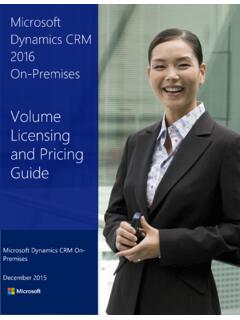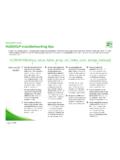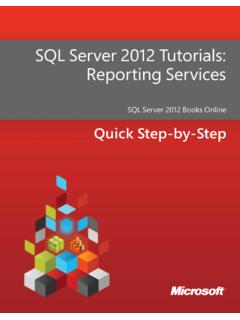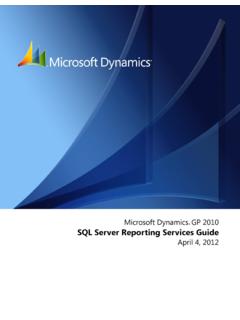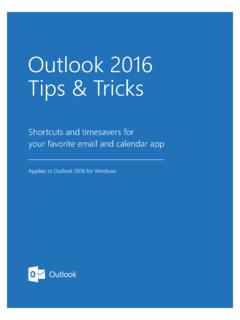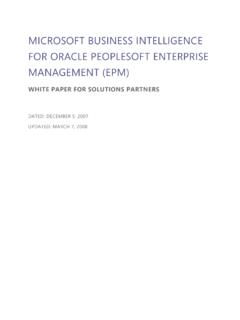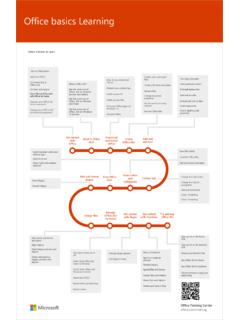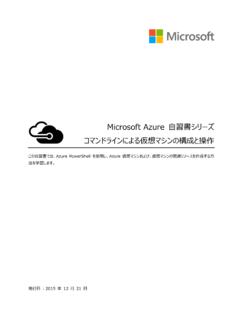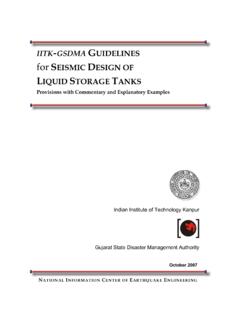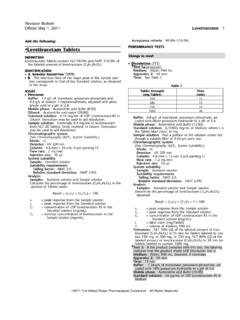Transcription of Protecting Data in Microsoft Azure
1 Protecting data in Microsoft Azure Protecting data in Microsoft Azure P A G E | 02 Abstract Microsoft is committed to ensuring that your data remains your data , without exception. When stored in Microsoft Azure , data benefits from multiple layers of security and governance technologies, operational practices, and compliance policies in order to enforce data privacy and integrity at a very granular level. This white paper describes such capabilities in Microsoft Azure , including mechanisms for encryption, secrets administration, and access control that you can leverage for managing sensitive data .
2 The sections that follow provide detailed guidance on how to use features in the Microsoft Azure platform to protect critical enterprise data in the cloud, whether structured or unstructured, in-transit, or at-rest. Audience This document focuses on data protection in Microsoft Azure , and is intended for Information Technology (IT) Professionals and IT Implementers who deal with information asset management on a daily basis, either as their main duties or as part of a broader cloud IT management role. This document will be most useful to individuals who are already familiar with Microsoft Azure , and are looking to increase their knowledge of tools and technologies for encryption, access control, and other aspects of data security in the platform and related services.
3 Sections , , and provide a brief overview of Azure and can be skipped depending on your existing knowledge of Azure services. NOTE: Certain recommendations contained herein may result in increased data , network, or compute resource usage, and increase your license or subscription costs. Published August 2014 (c) 2014 Microsoft Corporation. All rights reserved. This document is provided "as-is." Information and views expressed in this document, including URL and other Internet Web site references, may change without notice. You bear the risk of using it. Some examples are for illustration only and are fictitious.
4 No real association is intended or inferred. This document does not provide you with any legal rights to any intellectual property in any Microsoft product. You may copy and use this document for your internal, reference purposes. Protecting data in Microsoft Azure P A G E | 03 Table of Contents 1 OVERVIEW .. 5 2 data STORAGE IN Microsoft Azure .. 6 Microsoft Azure STORAGE .. 7 data Structures .. 7 data 8 Microsoft Azure SQL DATABASE .. 8 Azure SQL Database Structure .. 9 Microsoft Azure ACTIVE DIRECTORY .. 9 Azure Active Directory Architecture .. 9 WHO CAN ACCESS YOUR data ?.
5 10 Single Sign-On (SSO) .. 11 Two-Factor Authentication (2FA) .. 11 Access Controls: Subscriptions .. 12 Access Controls: Storage .. 12 Access Controls: Azure Tables vs. SQL Databases .. 12 3 UNDERSTANDING data SECURITY ..14 RISK AND RISK MANAGEMENT .. 14 Understanding data Risk .. 14 THREATS TO YOUR 15 data Attack Taxonomy .. 16 Microsoft Azure DEFAULT PROTECTION .. 16 data Security in Azure AD .. 19 PLATFORM ENCRYPTION .. 19 Encryption in Transit .. 20 VM to VM .. 20 Customer to Cloud .. 20 data DELETION .. 21 21 Microsoft Azure Storage .. 21 Microsoft Azure Virtual Machines.
6 22 Azure SQL Database .. 22 COMPUTE SECURITY FOR data IN USE .. 22 PHYSICAL data SECURITY .. 23 4 CUSTOMER-CONFIGURABLE PROTECTION ..24 VOLUME LEVEL ENCRYPTION .. 25 BitLocker Drive Encryption .. 26 Drive Encryption - Partners .. 26 Key Management and Security .. 27 Protecting data in Microsoft Azure P A G E | 04 Subscription and Service Certificates .. 27 ENCRYPTION FOR SQL SERVER IN Azure VIRTUAL MACHINES .. 28 Cloud Implementation .. 28 Azure RIGHTS MANAGEMENT SERVICES .. 30 RMS Basics: How the RMS Components Work Together .. 30 RMS Server Choices .. 31 RMS SDK for developers.
7 31 RMS-Aware Applications .. 32 RMS in Organizations .. 32 Key Management with RMS .. 32 Tracking Key Distribution .. 33 5 Protecting data THROUGH REDUNDANCY AND BACKUP ..34 Azure STORAGE .. 34 Azure BACKUP .. 35 STORSIMPLE CLOUD INTEGRATED STORAGE (CIS) .. 35 6 PRIVACY AND ACCOUNTABILITY ..36 7 SUMMARY ..37 8 REFERENCES AND FURTHER READING ..38 SOURCES .. 38 Protecting data in Microsoft Azure P A G E | 05 1 Overview There are multiple tools within Microsoft Azure to safeguard data according to your company s security and compliance needs. One of the keys to data protection in the cloud is accounting for the possible states in which your data may occur, and what controls are available for that state.
8 Specifically: At-rest: This includes all information storage objects, containers, and types that exist statically on physical media, be it magnetic or optical disk. In-Transit: When data is being transferred between components, locations or programs, such as over the network, across a service bus (from on-premises to cloud and vice-versa, including hybrid connections such as ExpressRoute), or during an input/output process, it is thought of as being in-motion. Being in-transit does not necessarily mean a communications process with a component outside of your cloud service; it moves internally, also, such as between two virtual networks.
9 In-use: (or in-process) Dynamic data usage could be a table kept in virtual memory, transactions in a message queue, or even encryption keys in the CPU cache. Information being acted upon in some way by the host or guest during a process, such as real-time database queries running in active memory (as opposed to a page file sent out to disk), could be in different security states depending on whether it is encrypted or decrypted, and the security context of the operator. Further, there are two (2) fundamental types of data at rest: 1. data in production. There is data in some form of storage, Azure SQL Database, and compute processes that need to access that storage during production operations.
10 In this case, encryption at rest is aimed at Protecting the data in that storage (whereas the compute aspect deals with data in use). 2. data not in production. There is data in some form of storage, a Virtual Hard Disk (VHD), but that VHD is not in production use. For example, it may be part of an upgrade operation, but the VHD has not yet been loaded or mounted. data encryption at rest is applicable here, but the compute aspect is not relevant for this scenario. As a result, you need to weigh the cost of protection in terms of compute cycles for cryptography, application performance, resource latency, management overhead, content classification and filtering, and rights management.

